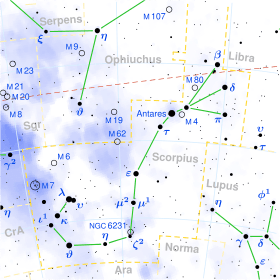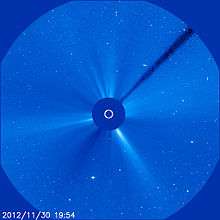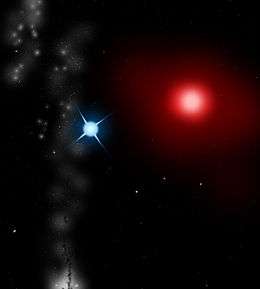Antares
 Antares in the constellation Scorpius | |
| Observation data Epoch J2000 Equinox J2000 | |
|---|---|
| Constellation | Scorpius |
| Right ascension | 16h 29m 24.45970s[1] |
| Declination | −26° 25′ 55.2094″[1] |
| Apparent magnitude (V) | +0.96[2] |
| Characteristics | |
| Evolutionary stage | Red supergiant |
| Spectral type | M1.5Iab + B2.5V[3] |
| U−B color index | +1.34[2] |
| B−V color index | +1.83[2] |
| Variable type | Lc[4] |
| Astrometry | |
| Radial velocity (Rv) | −3.4[5] km/s |
| Proper motion (μ) | RA: −12.11[1] mas/yr Dec.: −23.30[1] mas/yr |
| Parallax (π) | 5.89 ± 1.00[1] mas |
| Distance | approx. 550 ly (approx. 170 pc) |
| Absolute magnitude (MV) | −5.28[6] |
| Details | |
| A | |
| Mass | 12.4[3] M☉ |
| Radius | 883[3] R☉ |
| Luminosity | 57,500[7] L☉ |
| Surface gravity (log g) | 0.1[3] cgs |
| Temperature | 3400 ± 200[7] K |
| Rotational velocity (v sin i) | 20[2] km/s |
| B | |
| Mass | 7.2[8] M☉ |
| Radius | 5.2[8] R☉ |
| Surface gravity (log g) | 3.9[8] cgs |
| Temperature | 18,500[7] K |
| Rotational velocity (v sin i) | 250[8] km/s |
| Other designations | |
| Database references | |
| SIMBAD | data |
Antares (/ænˈtɑːriːz/), also designated Alpha Scorpii (α Scorpii, abbreviated Alpha Sco, α Sco), is the fifteenth-brightest star in the night sky; the brightest star in the constellation of Scorpius, and is often referred to as "the heart of the scorpion". Along with Aldebaran, Regulus, and Fomalhaut, Antares comprises the group known as the 'Royal stars of Persia'. It is one of the four brightest stars near the ecliptic.
Distinctly reddish when viewed with the unaided eye, Antares is a red supergiant of spectral type M0.5Iab and is one of the largest and most luminous observable stars. It is a slow irregular variable star with the quoted magnitude of +0.96. Antares is the brightest, most massive, and most evolved stellar member of the nearest OB association (the Scorpius–Centaurus Association). Antares is a member of the Upper Scorpius subgroup of the Scorpius–Centaurus Association, which contains thousands of stars with mean age 11 million years at a distance of approximately 145 parsecs (470 ly).[11]
Nomenclature
α Scorpii (Latinised to Alpha Scorpii) is the star's Bayer designation. The traditional name Antares derives from the Ancient Greek Άντάρης, meaning "equal to-Ares" ("equal to-Mars"), due to the similarity of its reddish hue to the appearance of the planet Mars.[12] The comparison of Antares with Mars may have originated with early Mesopotamian astronomers.[13] However, some scholars have speculated that the star may have been named after Antar, or Antarah ibn Shaddad, the Arab warrior-hero celebrated in the pre-Islamic poems Mu'allaqat.[13] In 2016, the International Astronomical Union organised a Working Group on Star Names (WGSN)[14] to catalog and standardise proper names for stars. The WGSN's first bulletin of July 2016[15] included a table of the first two batches of names approved by the WGSN; which included Antares for this star. It is now so entered in the IAU Catalog of Star Names.[16]
Properties

Antares is a supergiant star with a stellar classification of M0.5Iab.[17] With a radius that is approximately 883 times that of the Sun,[3] if placed in the center of the Solar System, its outer surface would lie between the orbits of Mars and Jupiter. Based upon parallax measurements, Antares is approximately 550 light-years (170 parsecs) from the Sun.[1] Its visual luminosity is about 10,000 times that of the Sun, but because the star radiates a considerable part of its energy in the infrared part of the spectrum, the bolometric luminosity equals roughly 65,000 times that of the Sun. The mass of the star has been calculated to be in the range of 15 to 18 solar masses.[18] A recent analysis[11] comparing the effective temperature and luminosity of Antares to theoretical evolutionary tracks for massive stars which include rotation and mass loss yielded a mass of approximately 17 solar masses and an age of 12 million years.
The size of Antares may be calculated using its parallax and angular diameter. The parallax angle is given in the adjacent box, and the angular diameter is known from lunar occultation measurements (41.3 ± 0.1 milliarcseconds).[19] This implies a radius of 890 ± 150 solar radii at this distance. By analysing its radial velocity from its spectrum, Pugh and colleagues calculated a period of 5.93 ± 0.01 years and considered whether this change was orbital or pulsational. If the latter, then the radius of the star changes by 165 ± 22 solar radii (19% ± 4%). However, if this were the case, Antares' brightness would vary by a greater amount.[20]
Antares is a type LC slow irregular variable star, whose apparent magnitude slowly varies from +0.6 to +1.6.[4]
Position

Antares is visible in the sky all night around May 31 of each year, when the star is at opposition to the Sun. At this time, Antares rises at dusk and sets at dawn as seen at the equator. For approximately two to three weeks on either side of November 30, Antares is not visible in the night sky, because it is near conjunction with the Sun;[21] this period of invisibility is longer in the Northern Hemisphere than in the Southern Hemisphere, since the star's declination is significantly south of the celestial equator.
Antares is one of the four first magnitude stars that lies within 5° of the ecliptic (like Spica, Regulus and Aldebaran) and therefore can be occulted by the Moon and, though rarely, by Venus. The last occultation of Antares by Venus took place on September 17, 525 BC; the next one will take place on November 17, 2400. Other planets have not occulted Antares in the last millennium nor will they do so in the next millennium, as they pass as a result of their actual node position and inclination always northward of Antares. On 31 July 2009, Antares was occulted by the Moon. The event was visible in much of southern Asia and the Middle East.[22][23] Every year around December 2 the Sun passes 5° north of Antares.[21]
Companion star

Antares has a secondary, or companion star, Antares B, that changed from an angular separation (from its primary, Antares A) of 3.3 arcseconds in 1854 to 2.86 arcseconds in 1990. It was first observed by Scottish astronomer James William Grant FRSE while in India on 23 July 1844.[24] The last is equal to a projected separation of about 529 astronomical units (AU) at the estimated distance of Antares, giving a minimum value for the separation of the pair. Spectroscopic examination of the energy states in the outflow of matter from the companion star suggests that it is about 224 AU beyond the primary,[3] giving a combined separation of about 574 AU.[25] The stellar classification of this star is B3V:,[17] with numerous spectral lines suggesting it has been polluted by matter ejected by Antares A.[3] At magnitude 5.5, it is only one 370th as bright visually as Antares A, although it shines with 170 times the Sun's luminosity.[18]
The companion star is normally difficult to see in small telescopes due to glare from Antares A, but can sometimes be seen in apertures over 150 millimetres (5.9 inches).[26] The companion is often described as green, but this is probably either a contrast effect[18] or the result of the mixing of light from the two stars when they are seen together through a telescope and are too close to be completely resolved. Antares B can sometimes be observed with a small telescope for a few seconds during lunar occultations while Antares A is hidden by the Moon. It was discovered by Johann Tobias Bürg during one such occultation on April 13, 1819,[27] but until its existence was confirmed in 1846 it was thought by some to be merely the light of Antares viewed through the Moon's atmosphere (which at the time was theorised to exist).[28] When observed by itself during such an occultation, the companion appears a profound blue or bluish-green color.[28]
The orbit of the companion star is poorly known, as attempts to analyse the radial velocity of Antares need to be unravelled from the star's own pulsations.[20] Orbital periods are possible within a range of 1,200[29] to 2,562 years.[30]
Supernova progenitor
_(Apr_2015_update).png)
1. Mercury < Mars < Venus < Earth
2. Earth < Neptune < Uranus < Saturn < Jupiter
3. Jupiter < Proxima Centauri < Sun < Sirius
4. Sirius < Pollux < Arcturus < Aldebaran
5. Aldebaran < Rigel < Antares < Betelgeuse
6. Betelgeuse < VY Canis Majoris < NML Cygni < UY Scuti.
Antares, like the similarly-sized red giant Betelgeuse in the constellation Orion, will almost certainly explode as a supernova,[31] probably within the next few hundred thousand years. For a few months, the Antares supernova could be as bright as the full moon and be visible in daytime.[32]
Other names
- In ancient Mesopotamia, Antares may have been known by the following names: Urbat, Bilu-sha-ziri ("the Lord of the Seed"), Kak-shisa ("the Creator of Prosperity"), Dar Lugal ("The King"), Masu Sar ("the Hero and the King"), and Kakkab Bir ("the Vermilion Star").[13]
- In Persia, Antares was known as Satevis, one of the four "royal stars".[33]
- In India, it with σ and τ Sco were Jyeshthā (the eldest or biggest), one of the nakshatra (Hindu lunar mansions).[13]
- The Wotjobaluk Koori people of Victoria, Australia, knew Antares as Djuit, son of Marpean-kurrk (Arcturus); the stars on each side represented his wives. The Kulin Kooris saw Antares (Balayang) as the brother of Bunjil (Altair).[34]
- The Māori people of New Zealand call Antares Rehua, and regard it as the chief of all the stars. Rehua is father of Puanga/Puaka (Rigel), an important star in the calculation of the Māori calendar.
- The ancient Chinese called Antares (Chinese: 心宿二; pinyin: Xīn Sùèr; literally: "second-brightest"), because it was the second-brightest star of the mansion Xin (心). It was the national star of the Shang Dynasty, and it was sometimes referred to as (Chinese: 火星; pinyin: Huǒxīng; literally: "fiery star") because of its reddish appearance.
Alternative names of this star, meaning "the Heart of Scorpion":
- In ancient Egypt, Antares represented the scorpion goddess Serket (and was the symbol of Isis in the pyramidal ceremonies).[13]
- Antares is listed in MUL.APIN as GABA GIR.TAB, meaning "the Breast of the Scorpion: Lishi, Nabu".[35]
- Calbalakrab from the Arabic Qalb al-Άqrab.[36] This had been directly translated from the Ancient Greek Καρδία Σκορπίου Kardia Skorpiū.
- Cor Scorpii translated above Greek name into Latin.[13]
See also
Footnotes
References
- 1 2 3 4 5 6 van Leeuwen, F. (November 2007). "Validation of the new Hipparcos reduction". Astronomy and Astrophysics. 474 (2): 653–664. arXiv:0708.1752
 . Bibcode:2007A&A...474..653V. doi:10.1051/0004-6361:20078357.
. Bibcode:2007A&A...474..653V. doi:10.1051/0004-6361:20078357. - 1 2 3 4 HR 6134, database entry, The Bright Star Catalogue, 5th Revised Ed. (Preliminary Version), D. Hoffleit and W. H. Warren, Jr., CDS ID . Accessed on line September 07, 2012.
- 1 2 3 4 5 6 7 Baade, R.; Reimers, D. (October 2007). "Multi-component absorption lines in the HST spectra of α Scorpii B". Astronomy and Astrophysics. 474 (1): 229–237. Bibcode:2007A&A...474..229B. doi:10.1051/0004-6361:20077308.
- 1 2 Kiss, L. L.; Szabo, G. M.; Bedding, T. R. (2006). "Variability in red supergiant stars: pulsations, long secondary periods and convection noise". Monthly Notices of the Royal Astronomical Society. 372 (4): 1721–1734. arXiv:astro-ph/0608438
 . Bibcode:2006MNRAS.372.1721K. doi:10.1111/j.1365-2966.2006.10973.x. ISSN 0035-8711.
. Bibcode:2006MNRAS.372.1721K. doi:10.1111/j.1365-2966.2006.10973.x. ISSN 0035-8711. - ↑ Evans, D. S. (June 20–24, 1966). "The Revision of the General Catalogue of Radial Velocities". In Batten, Alan Henry; Heard, John Frederick. Determination of Radial Velocities and their Applications, Proceedings from IAU Symposium no. 30. Determination of Radial Velocities and their Applications. 30. University of Toronto: International Astronomical Union. p. 57. Bibcode:1967IAUS...30...57E.
- ↑ Buick, Tony (2010). "Classification of the Stars". The Rainbow Sky. Patrick Moore's Practical Astronomy Series. pp. 43–71. doi:10.1007/978-1-4419-1053-0_4. ISBN 978-1-4419-1052-3. ISSN 1431-9756.
- 1 2 3 Schröder, K.-P.; Cuntz, M. (April 2007), "A critical test of empirical mass loss formulas applied to individual giants and supergiants", Astronomy and Astrophysics, 465 (2): 593–601, arXiv:astro-ph/0702172
 , Bibcode:2007A&A...465..593S, doi:10.1051/0004-6361:20066633
, Bibcode:2007A&A...465..593S, doi:10.1051/0004-6361:20066633 - 1 2 3 4 Kudritzki, R. P.; Reimers, D. (1978). "On the absolute scale of mass-loss in red giants. II. Circumstellar absorption lines in the spectrum of alpha Sco B and mass-loss of alpha Sco A". Astronomy and Astrophysics. 70: 227. Bibcode:1978A&A....70..227K.
- ↑ Allen, Richard Hinckley (1899). Star-names and their meanings. G. E. Stechert. pp. 364–367. Retrieved 2011-12-31.
- ↑ "ANTARES -- Double or multiple star". SIMBAD. Centre de Données astronomiques de Strasbourg. Retrieved 2011-12-31.
- 1 2 Mark J. Pecaut; Eric E. Mamajek & Eric J. Bubar (February 2012). "A Revised Age for Upper Scorpius and the Star Formation History among the F-type Members of the Scorpius-Centaurus OB Association". Astrophysical Journal. 746 (2): 154. arXiv:1112.1695
 . Bibcode:2012ApJ...746..154P. doi:10.1088/0004-637X/746/2/154.
. Bibcode:2012ApJ...746..154P. doi:10.1088/0004-637X/746/2/154. - ↑ Gettings, Fred ♦ The Arkana Dictionary of Astrology Penguin Books, 1985, p. 24 ♦ "Antares: Sometimes called Antar, in confusion with a literary hero (see Allen), the modern name is said to be derived from its red colour, in that it was rival even of the planet Mars—the Greek, anti-Ares."
- 1 2 3 4 5 6 Allen, R. H. (1963). Star Names: Their Lore and Meaning (Reprint ed.). New York, NY: Dover Publications Inc. pp. 364–366. ISBN 0-486-21079-0.
- ↑ "IAU Working Group on Star Names (WGSN)". Retrieved 22 May 2016.
- ↑ "Bulletin of the IAU Working Group on Star Names, No. 1" (PDF). Retrieved 28 July 2016.
- ↑ "IAU Catalog of Star Names". Retrieved 28 July 2016.
- 1 2 Corbally, C. J. (August 1984), "Close visual binaries. I - MK classifications", Astrophysical Journal Supplement Series, 55: 657–677, Bibcode:1987A&AS...67...95D, doi:10.1086/190973.
- 1 2 3 Kaler, James. "Antares". Retrieved 13 August 2008.
- ↑ A. Richichi (April 1990). "A new accurate determination of the angular diameter of Antares". Astronomy and Astrophysics. 230 (2): 355–362. Bibcode:1990A&A...230..355R.
- 1 2 Pugh, T.; Gray, D.F. (2013). "On the Six-year Period in the Radial Velocity of Antares A". The Astronomical Journal. 145 (2): 4. Bibcode:2013AJ....145...38P. doi:10.1088/0004-6256/145/2/38. 38.
- 1 2 Star Maps created using XEphem (2008). "LASCO Star Maps (identify objects in the field of view for any day of the year)". Large Angle and Spectrometric Coronagraph Experiment (LASCO). Retrieved 2011-12-01. (2009, 2010, 2011)
- ↑ "Occultation of Antares on 31 July 09". The International Occultation Timing Association. Archived from the original on 5 July 2009. Retrieved 2 August 2009.
- ↑ "Sky watchers report occultation of Antares by moon". The Times Of India. 2 August 2009.
- ↑ https://en.wikisource.org/wiki/Grant,_James_William_(DNB00)
- ↑ From the Pythagorean theorem, the separation s is given by:
- ↑ Schaaf, Fred (2008). The Brightest Stars: Discovering the Universe Through the Sky's Most Brilliant Stars. John Wiley and Sons. p. 218. ISBN 978-0-471-70410-2.
- ↑ Burnham, Robert, Jr. (1978). Burnham's Celestial Handbook. New York: Dover Publications. p. 1666.
- 1 2 S.J. Johnson, "Occultation of Antares." The Observatory, Vol. 3, pp. 84-86 (1879)
- ↑ Hartkopf, W.I.; Mason, B.D.; Worley, C.E. (2001). "The 2001 US Naval Observatory Double Star CD-ROM. II. The Fifth Catalog of Orbits of Visual Binary Stars". The Astronomical Journal. 122 (6): 3472–3479. Bibcode:2001AJ....122.3472H. doi:10.1086/323921.
- ↑ Reimers, D.; Hagen, H. -J.; Baade, R.; Braun, K. (2008). "The Antares emission nebula and mass loss of α Scorpii A". Astronomy and Astrophysics. 491: 229–238. arXiv:0809.4605
 . Bibcode:2008A&A...491..229R. doi:10.1051/0004-6361:200809983.
. Bibcode:2008A&A...491..229R. doi:10.1051/0004-6361:200809983. - ↑ Firestone, R. B. (July 2014), "Observation of 23 Supernovae That Exploded <300 pc from Earth during the past 300 kyr", The Astrophysical Journal, 789 (1): 11, Bibcode:2014ApJ...789...29F, doi:10.1088/0004-637X/789/1/29, 29". See p. 10."
- ↑ Hockey, T.; Trimble, V. (2010). "Public reaction to a V = -12.5 supernova". The Observatory. 130: 167. Bibcode:2010Obs...130..167H.
- ↑ Allen, R. H. (1963): According to Charles François Dupuis, a French astronomical writer
- ↑ Mudrooroo (1994). Aboriginal mythology : an A-Z spanning the history of aboriginal mythology from the earliest legends to the present day. London: HarperCollins. p. 5. ISBN 1-85538-306-3.
- ↑ Rogers, J. H. (February 1998). "Origins of the ancient constellations: I. The Mesopotamian traditions". Journal of the British Astronomical Association. 108 (1): 9–28. Bibcode:1998JBAA..108....9R.
- ↑ Kunitzsch, P. (1959). Arabische Sternnamen in Europa. Wiesbaden: Otto Harrasowitz. p. 169.
External links
| Wikimedia Commons has media related to Antares. |
- Antares on WikiSky: DSS2, SDSS, GALEX, IRAS, Hydrogen α, X-Ray, Astrophoto, Sky Map, Articles and images
- Antares at Constellation Guide
Coordinates: ![]() 16h 29m 24s, −26° 25′ 55″
16h 29m 24s, −26° 25′ 55″